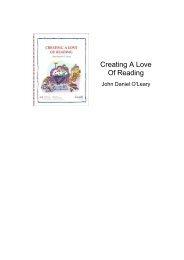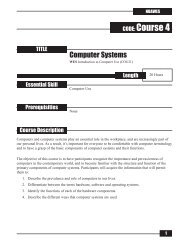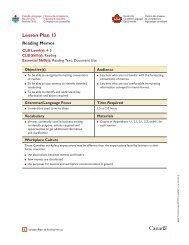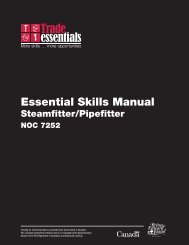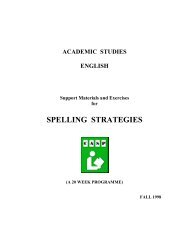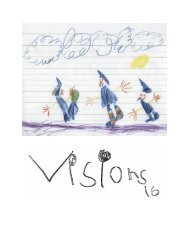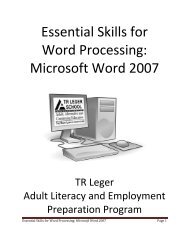Integrating Essential Skills into Training - National Adult Literacy ...
Integrating Essential Skills into Training - National Adult Literacy ...
Integrating Essential Skills into Training - National Adult Literacy ...
Create successful ePaper yourself
Turn your PDF publications into a flip-book with our unique Google optimized e-Paper software.
Background and Context<br />
Specific Example: Data Tables<br />
How can we use tables to sort<br />
and obtain information?<br />
HOW TO DELIVER A LESSON ON TABLES<br />
What is the workplace task? Using tables, schedules and production plans<br />
What kind of tables do we use<br />
at work?<br />
What is a table?<br />
Why do we use tables?<br />
Application Exercises<br />
Applying concepts to another<br />
set of information<br />
A closer look at table structure<br />
Brainstorm a list with trainees (e.g.) inventory control sheets, hours<br />
worked logs, production plans, class lists, teaching timetables,<br />
students assessment tables, holiday schedules, calendars, hours of<br />
operation schedules, shift rotation schedules, equipment sign out<br />
lists, interest rate tables, loan repayment schedules, etc.<br />
Ask trainees to develop a definition based on the examples of tables<br />
they listed above. For example:<br />
a table is a group of lists<br />
a table has headings (across the top, down the side or both)<br />
columns in a table can be read as a series of vertical lists<br />
rows in a table can be read as a series of horizontal lists<br />
lists in a table can be read both vertically and horizontally<br />
a table has a title that says what the table is about<br />
a table can have words, numbers or pictures<br />
Brainstorm some ideas with trainees. For example:<br />
to present information so it can be read quickly<br />
to put information <strong>into</strong> categories<br />
to show how types of information interact with each other<br />
to make it easy to write information (few words are needed)<br />
•<br />
•<br />
•<br />
Refer trainees to the sewing machine document they used in the<br />
morning interviewing exercise.<br />
Ask trainees to complete the Equipment Specifications Table<br />
Exercise in pairs. (This exercise can be completed with tool or<br />
equipment lists of any kind as well as materials lists, product lists,<br />
etc). This is a good exercise to get trainees to understand product<br />
specifications and to learn about the tools, equipment and<br />
materials used in their studies. This exercise also shows how<br />
categories in a table are dependent on what kinds of information<br />
readers need and what kinds of information are available.<br />
Debrief as a group.<br />
Repeat the exercise using information from product ads (televisions<br />
and vehicles). This exercise can be done using supplier catalogues,<br />
product brochures, actual products (market research), etc.<br />
Ask trainees to look at the stock market and mortgage rate tables.<br />
Discuss how the information is arranged, which other columns could<br />
be the lead column and why, what changes to the order would have<br />
to be made. Using these kinds of tables allows for lessons on the<br />
stock market and market listing, and mortgages and home purchses.




